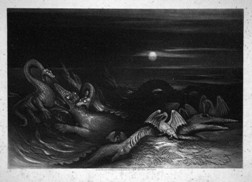
Geologist and science writer, Nina Morgan, experiences the thrills and chills of science writing in the 19th Century
Geoscientist 20.7 July 2010
When it comes to promoting science, capturing the public imagination is a key goal. But achieving this can be difficult. Finding the right balance between education and entertainment has always proved problematic. The standard advice for successful presentations of any kind is to know and play to your audience. In the 19th Century, the public preferred to take their science on board as a spectacle. Models, dramatic visual displays and galleries of curiosities were all popular. The same applied to popular science writing. Animated language and highly imaginative descriptions were deemed to be what the public wanted. And from the fossil collector and author Thomas Hawkins (1810-1889), this is certainly what they got!
Hawkins collected and prepared (some would say over-prepared) important collections of ichthyosaurs and plesiosaurs from the Jurassic rocks in quarries in Somerset, and also purchased specimens from professional collectors such as Mary Anning. Many of the specimens that he sold or donated to the British Museum of Natural history and the natural history museums at Oxford and Cambridge are still on display. But although he was respected as a collector and preparator, Hawkins was notoriously eccentric. He wrote crank letters to the great and good, as well as to newspapers. And in the 1871 Census he described himself as the 'Rightful Earl of Kent'.
This aspect of his personality stood him in good stead when it came to popularising geology. In massive tomes with titles like Memoirs of Ichthyosauri and Plesiosauri, extinct monsters of the ancient earth, and The Book of the Great Sea-Dragons, he described the imagined appearance and lifestyle of these Liassic marine reptiles in vivid and gruesome terms. For example, in the Book of Great Sea-Dragons he discusses the “exquisite” killing machines from which “our Naval Architects might learn a lesson or two”.
His descriptions of an ichthyosaur as an “ardent Monster fleeting through the expanse of Seas like lightning to his distant prey, with a lust unquenchable in gore”, and the “deathly paddles of Pleisiosaurus... his hide, black or freckled or russet, his eyes blood-shot fiery, or green, lizard-like; his teeth whetted sharp, gloating upon and crunching the gristles of his dying prey” must certainly have sent shivers down the spines of his readers. With technicolour prose like that, who needs Jurassic Park?
Acknowledgments
Sources for this vignette include
Thomas Hawkins and geological spectacle by Ralph O'Connor, Proceedings of the Geologists Association, vol 114, 2003, pp.227-241, from which the quotes from Hawkins' books are taken; and Oxford Dictionary of National Biography entry for Thomas Hawkins by Michael Taylor.
Hawkins's life and work will be discussed at the Geological Curators Group Seminar meeting this month: 200 years of West Country Sea Dragons - 23 July 2010 at the Strode Theatre, Street, Somerset. The meeting will be followed by a field excursion on 24 July to visit some of the modern Lias quarries in the Street area.
For more information contact: Dr Leslie Noe Curator of Natural Science, Thinktank, Birmingham Science Museum, Millennium Point, Curzon Street, Birmingham B47XG E:
[email protected].
- If the past is the key to your present interests, why not join the History of Geology Group (HOGG). For more information and to read the latest HOGG newsletter, visit: www.geolsoc.org.uk/hogg.